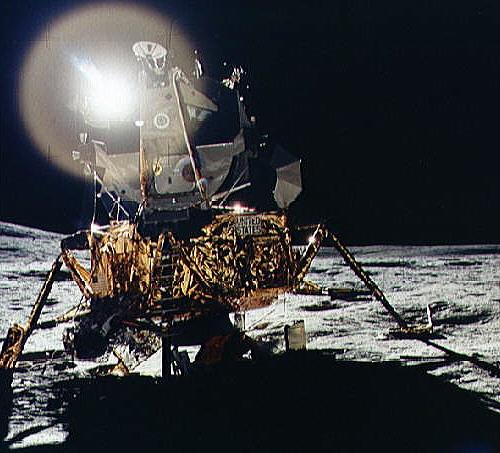The thing to remember about Apollo is that from the moment the Saturn V rocket left the launch pad right up to "splash down" - the flow of information was controlled solely by NASA. Which is a military organisation in all but name.
Now, if you are an adherent of Science and you DON'T hear alarm bells reading the above statement there is a very serious disconnect somewhere.
Philosophically speaking, "Science" & "Authority" are about as far apart on the spectrum as you can get. Yet today the two words have all but become synonymous. I propose that this is a VERY BAD thing. It always has been. It always will be.
Returning to the issue of the photographs - I tend not to spend too much time on the question of shadows. Whilst it is true that there are some clearly ludicrous examples which can only be fakes - in many cases the question can become mired in complexity and ultimately nonproductive.
IMO, there are far more vulnerable regions where the photographic evidence can be attacked - such as visible light-intensity falloff which simply cannot be explained by anything other than a close light source.
Then there is the issue of image DETAIL. Our eyes are keyed to sensing and interpreting minute changes in light and shadow. The interaction of both in ways our brains are hard-coded to be more or less receptive to is what makes a good or bad photograph.
We intuitively understand what takes place at both ends of the process of sensing and interpreting. But the precise mechanism of transformation is still a bit of a mystery.
It's the reason for arguably the most common mistake all photographers make - including pros. Anyone who has ever picked up a camera will recall seeing some absolutely stunning interplay of light and shadow, grabbing the camera and pressing the shutter.
Breathless with anticipation they download the image into Adobe RAW/Capture One only to notice that either they've blown out the highlights (overexposed) or the shadows (underexposed) and the image looks nothing like what they remember.
They have just run into the problem of "tonal" or "dynamic range". You see, whilst the human eye can (in certain circumstances) differentiate up to fifteen stops of light intensity - cameras are less able to cope with variation.
Imagine a scale of 1-20 with complete darkness at 1 and unbearable brightness sitting at the other end. Any sensor (whether it be biological or machine) which could differentiate all 20 levels at the same time could be said to see EVERYTHING.
A sensor which can detect 15 consecutive levels is still pretty effective - but given that it will still miss five a decision must be made on which end of the scale you plan to cover. If you are expecting a bright photograph then you would logically position the low end of the range at the 5th level so that you capture everything up to twenty. Providing light intensity stays between 5 and 20 you will record everything in perfect clarity. But should ANY part of the scene fall below 5 (and thus outside your 15-stop recording range) it will appear completely black. Underexposed. A silhouette. Conversely, should you be expecting a dark image and you begin at position 1 right up to 15 - anything which is brighter than 15 will appear completely white. Overexposed.
Digital/film cameras are almost always far worse at coping with varying light intensity than the human eye. Many digital cameras struggle coping with a mere SIX STOPS difference. Film cameras (such as the Hasselblad) are better. But they are by no means perfect.
Which is a MAJOR PROBLEM when you are in an ultra-high contrast environment such as the moon where there is no atmosphere to soften direct sunlight and fill in the shadows.
Indeed, as environments go the Moon must ultimately be rated as a NIGHTMARE by even the most experienced of photographers.
How can you take a photograph in direct sunlight without blowing out the highlights and/or underexposing the shadow regions? The answer is - YOU CAN'T without the use of supplementary light sources (fill flash) and/or reflectors. Yet time and time again we see Apollo photos in which BOTH regions are perfectly exposed.
It's hard enough doing this is direct sunlight on EARTH where you have an atmosphere scattering light which can be pulled in as fill and highly reflective surfaces which can also serve this purpose.
And bear in mind that this film was rated 160ASA. That's PITIFUL by today's high ISO standards.
Now remember that these guys were not pro photographers. They were using arguably one of the most difficult cameras in the world to operate (even though it delivers superb optical results) - made even more so by the removal of the viewfinder and the astronauts limited field of vision.











